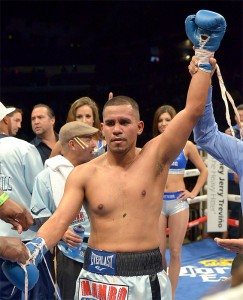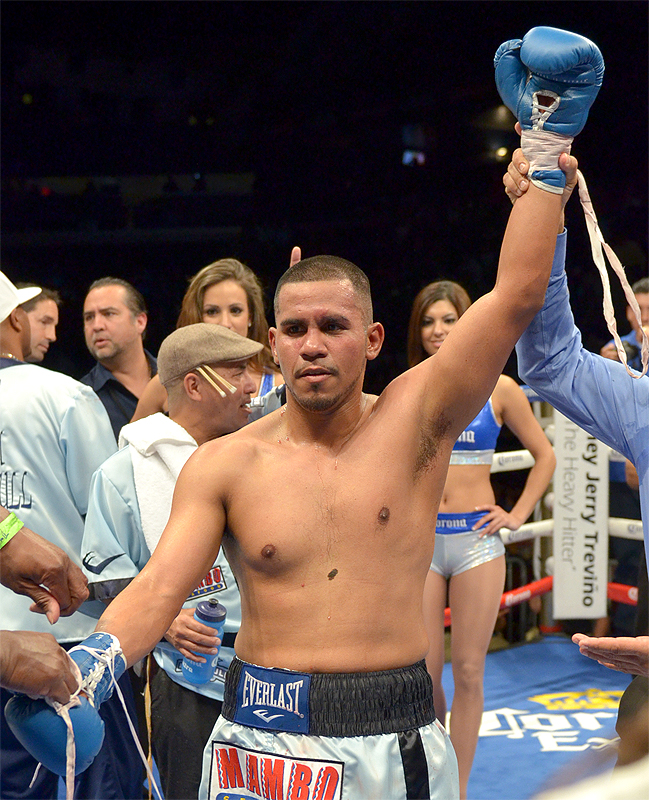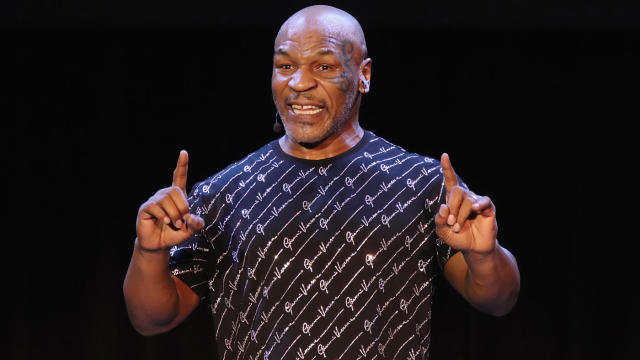
LAREDO, Texas – Saturday at this city’s Energy Arena brought nothing unexpected, and perhaps 1,000 or so spectators, with the red corner going 6-0 (5 KOs), and Houston lightweight Juan “Baby Bull” Diaz winning the second fight of his comeback by a technical knockout that brought two white terrycloths flying in the ring from the corner of Diaz’s Brazilian opponent, Adailton De Jesus, in round 5. Saturday also brought recognition Diaz did not dissipate during his brief consideration of a career in pettifogging instead of prizefighting, and perhaps a wee bit of observational inadequacy too.
Even sitting 15 feet from Diaz and making him one’s sole point of concentration yields few fruitful revelations about the origins of his stamina. The question was got at a number of times from different angles during Diaz’s reign as lightweight champion, and usually, and properly, attributed to the smoothness of his physique, the languid shape and execution of his fatty-wrapped though not-nonexistent musculature – won by hours swimming laps in lieu of pumping reps, a physique naturally warmed by driving a baseball bat in a heavybag rather than snapping bicep-tightening uppercuts at a trainer’s handpads.
Diaz’s footwork is not spectacular, though he is rarely off balance in any way but one customary to volume punchers: weight too far forward, body draped over the left knee. Diaz remains, as ever, a proverbial sucker for the back uppercut, the punch Juan Manuel Marquez finished him with in the second loss of his career, a punch it takes a gambler to throw since it opens his chin to a left hook, a punch Diaz throws nearly well to the head as he throws to the body.
Diaz does that with an untold ferocity; it was the only part of being ringside for his Saturday fight with Adailton De Jesus that carried something unexpected: Diaz does not know he does not possess one-punch stopping power, or at least he fights like a man who does not know. He is instead a man who must apply geology’s study of pressure and time to undo the wills of other men who hurt other men for a living, to snatch their desire to punch him by showing them a different nature, a beast they’ve not seen, one who will not tire and will not stop punching them. While there is not one Diaz punch or even one Diaz combination that makes an opponent wince at the championship level, there is a relentlessness that raises an exasperation the peerless Larry Merchant once captured in a fittingly exasperated voice: What do I have to do to make this guy stop hitting me?
Opponents, and more so bystanders, see Diaz’s flaccid physique, the way his flesh tumbles harmlessly over the black waistband of his babyblue trunks, and suspect whatever viciousness he brings to the opening minutes is mere hot blood, akin to prison-yard fury. It’s not till the 15th minute opponents, and more so bystanders, begin to wonder what detail they missed about this friendly college grad any barroom tough would unhesitatingly accost, how in the holy hell Diaz has not relented one moment, how he could appear so physically unprepared for a craft he is so masterful at.
That’s when many a Diaz opponent makes the worst possible calculation, to try rope-a-doping a smart guy, to begin stopping each of Diaz’s punches with his body rather than slipping or ducking them – because, really, what could be the harm: The Baby Bull famously does not hit hard. The harm is this: by stopping Diaz’s punches for him, doing half his physical work, an opponent reaffirms Diaz’s fighting philosophy relentlessly as Diaz’s punches can be thrown. “This is comfortable,” Diaz thinks, “this feels right, this is like we do in the gym on those days when if they didn’t yell ‘Time!’ a 23-minute round could happen because when I’m in my place, turning into each punch turns me away from the next punch till the motion takes care of itself and I barely know or remember what happened that last half hour.”
Diaz keeps his hands open wide as his battleship-gray gloves allow until the last three or so inches before they crash against an opponent’s body, and at that instant he closes them into fists, providing just enough torque to make another prizefighter know he’s being hit by a prizefighter, not a soft, local-attraction, college-kid-makes-good, slapper, twisting his knuckles in the man’s elbows and shoulders and ears till that man’s capacity for proper defense is pulverized, and Diaz’s knuckles start to taste what’s tastier: ribs, cheeks, chin, liver. Diaz follows every clean punch with another clean punch; he does not pause if a left hook makes another man’s bones momentarily feel like lard on his fist, he does not “take a snapshot” – as promoter Oscar De La Hoya rightly accused Danny Garcia of doing in Diaz’s native Houston against Erik Morales – but instead watches with eyes big the other man’s sternum, a head’s length below the man’s now exposed chin.
What Diaz does to another in a prizefight is an entirely impersonal event, it is a fitness contest with a heavybag that occasionally punches back, and whether that man tires or does not is an afterthought to Diaz who has a tally of fully thrown punches to reach, 600 at least though perhaps 900, before he asks what his opponent is doing. It is a mindlessness mindfully planned that makes Diaz susceptible only to men who are more accurate than he, and derive deeper pleasure from meaningful punches perfectly delivered, and such men are rare.
That is why Adailton De Jesus’ cornermen threw one white towel over the rope just after the midway point of round 5, and when that didn’t make referee Jon Schorle make Diaz relent, they hurled a second towel at Schorle himself, bypassing decorum to demand mercy for their charge.
Bart Barry can be reached at bart.barrys.email (at) gmail.com










